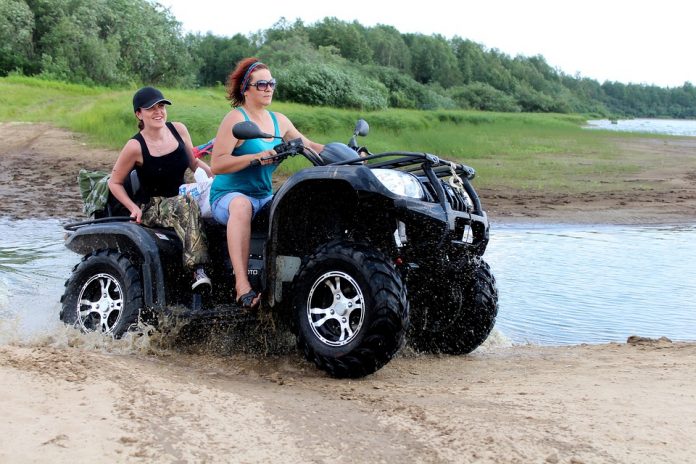ATVs and other types of ORVs are popular year-round utility and recreational vehicles that can offer hours of enjoyment for outdoor enthusiasts, as long as you obey the law and follow safety precautions. This information will help you enjoy your ATV/ORV safely.
Beginning July 1, 2015, the province is implementing new changes to ORV and ATV. These changes include:
- Allowing more types of off-road vehicles (ORVs) and all-terrain vehicles (ATVs) – including two-up ATVs, side-by-side ORVs and utility terrain vehicles (UTVs) – on the shoulder of public roads, where permitted
- Mandating that all riders – including drivers and passengers of all ages – wear an approved motorcycle helmet and use a seatbelt or foot rests, where applicable
- Children under the age of eight will not be allowed as a passenger on any ATV/ORV operating on-road
- Limiting the number of passengers to the number of available seating positions
- Requiring compliance labels on all ATVs/ORVs
- Clarifying access and exemptions for farmers and trappers and for Far Northern Ontario municipalities
Smart Ride Safe Ride ATV/ORV Handbook
The Smart Ride Safe Ride handbook outlines the rules and requirements for ATVs and ORVs. It will tell you:
- where you can ride your ATV/ORV
- who can drive an ATV/ORV in Ontario
- the road rules you need to follow
- how to be a safe and responsible ATV/ORV rider
On-road riding
ATV/ORV requirements
Some ATVs/ORVs can travel along certain provincial highways and on municipal roads, if the municipality has a bylaw permitting on-road ATV/ORV use.
For the purposes of on-road riding, a single-riderATV is a type of ORV that has:
- four wheels that contact the ground
- steering handlebars
- a seat that is straddled by the driver
- designed for a driver only and no passenger
Only an ATV/ORV that meets these standards can be used on the road. They must also meet other equipment-related requirements.
For more information about these requirements. click here
Where to ride
Permitted ATVs/ORVs can travel on:
- Highways 500 to 899
- many 7000-series highways
- highways with low traffic volumes
ATVs/ORVs cannot travel on:
- 400-series highways
- the Queen Elizabeth Way
- sections of the Trans-Canada Highway
For a complete list of provincial highways where on-road ATV/ORV use is permitted, please refer to Ontario Regulation 316/03. Schedule B and for a list of provincial highways where on-road use is prohibited. Please refer to Ontario Regulation 316/03 ScheduleA.
For a list of highways in Ontario where ATVs are prohibited from crossing, please check Schedule 1 of Regulation 863 of the Off-Road Vehicles Act.
Who can ride
For on-road riding, an ATV/ORV driver must:
- be at least 16 years old
- hold at least a valid G2 or M2 licence
- wear an approved motorcycle helmet, securely fastened under the chin with a chin strap
- wear a seat belt, where provided
- travel at speeds less than the posted speed limit, as outlined below
For on-road riding, a passenger on an ATV/ORV:
- cannot be under the age of eight
- must wear a seat belt or use foot rests, when applicable
- must wear an approved motorcycle helmet, securely fastened under the chin with a chin strap
Rules of the road
ATVs/ORVs on the road must travel at speeds less than posted speed limit:
- no more than 20 km/h on roads with a posted speed limit of 50 km/h or less
- no more than 50 km/h on roads with a posted speed limit greater than 50 km/h
Municipalities may set lower speed limits or additional rules for ATVs/ORVs.
ATVs/ORVs travelling along a road must:
- be driven in the same direction as traffic
- travel on the shoulder – if the shoulder is unsafe or impassable or not wide enough, an ATV/ORV can be driven on the travelled portion of the road
- have headlights and tail lights on
Off-road riding
Your vehicle
For off-road riding, your ATV must be registered and display a rear licence plate (except in exempt areas like far northern Ontario). It must be insured under a motor vehicle liability policy.
These requirements also apply to other types of (ORVs) including two-up ATVs side-by-side ORVs and utility terrain vehicles.
Who can drive
For off-road riding, an ATV/ORV driver must:
- be at least 12 years old, unless directly supervised by an adult or while driving on land occupied by the owner of the ATV/ORV
- carry the ATV/ORV’s registration permit or a true copy
Drivers and passengers must wear an approved motorcycle helmet, securely fastened under the chin with a chin strap.
Where to ride Crossing a Highway
The driver can directly cross a highway on an ATV/ORV where permitted only if:
- it is registered and displays a rear licence plate
- it is insured under a motor vehicle liability policy
- the driver is at least 16 years old and has a valid driver’s licence of any class
- the driver and passengers are wearing approved motorcycle helmets, securely fastened under the chin with a chin strap
For a list of highways in Ontario where AVTs/ORVs are prohibited from crossing, please check Off-Road Vehicles Act.
Exemptions
Exemptions can be found in the Ontario Regulation 316/03.
Beginning July 1, 2015, farmers and trappers and public work employees are exempt from ATV/ORV width and weight restrictions while performing commercial duties. Additionally, municipalities in Far Northern Ontario may prohibit the use of ATVs/ORVs on certain roads.
Be a safe and responsible rider
- take an ATV/ORV safety course and learn to ride from an expert
- know your ATV/ORV and read its operator’s manual before you ride
- graduated licensing requirements apply to young and novice drivers when driving on-road
- do a pre-ride inspection and check oil, gas and other fluid levels, lights, brakes and tire pressure
- stay in control – never ride beyond your skill level or abilities
- always ride according to trail, road and weather conditions
- use extreme caution when turning, crossing, climbing and descending hills – always cross obstacles using the proper technique
- drive sober – it’s against the law to drive while impaired by alcohol or drugs. They will affect your judgement and slow your reaction time
- ride with others and always let someone know where you’re going and when you expect to return
- be responsible and courteous, and respect others on the trail
- ride in designated areas only.
- Preserve the environment and keep noise levels low
Source: http://www.mto.gov.on.ca/english/driver/drive-ATV.shtml



















